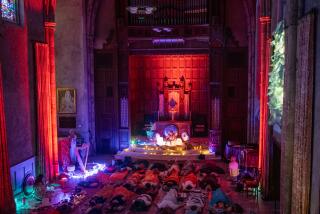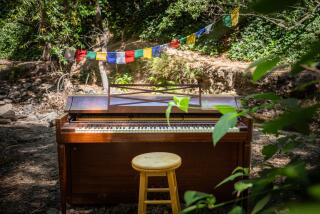THOUSAND OAKS : Pipe Organ’s Sounds Fill CLU Chapel
- Share via
Carl Swanson slipped on thin, black, leather shoes so he could feel the mammoth organ’s pedal board with his toes and switched to his reading glasses.
Only then did the Cal Lutheran University music professor settle down to play a little Johann Sebastian Bach. It was “Toccata and Fugue in D Minor,” to be exact, a piece Swanson will perform Oct. 18 at a 10 a.m. dedication service for the new Brughild Frances Petersen Memorial Organ.
Looking rather like the Wizard of Oz, Swanson sat at the 26-foot-tall instrument, its bronze, zinc and copper pipes reflecting light from stained glass windows.
Swanson flicked a button and played a melody through three tiers of brass Spanish trumpets--58 trumpets in all. Pushing another button, he spun the star set in the organ frontispiece and sounded the cymbalstern bell.
The Steiner-Reck organ, purchased with a single donation of $287,000, was built to fit the university’s Samuelson Chapel. The majestic instrument is something to be seen--and heard.
Crafted in white oak, with a rosewood pedal board and keys, the organ almost touches the ceiling. The tallest of its 2,009 pipes is 16 feet high, while its smallest is no larger than a three-inch hollow nail.
The organ breathes a powerful bass as Swanson’s feet flit over the pedals. His fingers set off a reaction that allows the pipes to sing the high notes.
“I’m talking through it,” Swanson said. “It’s thrilling.”
Swanson played a much smaller organ before the new one was installed, a feat that took four men nearly two months to finish.
Unlike most organs designed in the past 50 years, this one works the same way as those constructed during Bach’s time, between 1685 and 1750. The difference is a mechanical, as opposed to electrical, trigger that allows wind to blow through the pipes. The old-style mechanical action, he said, gives the organist more control over the sounds.
“The craftsmanship of this is really remarkable. It’s beautiful to look at and well-done on the inside,” he said, opening the organ’s back doors to display row upon row of variously shaped and sized pipes. The organ’s 28 registers are spread among 38 sets of pipes, the shape and metal alloy of which determine pitch.
A nationwide shortage of organists and organ students has Swanson worried. He hopes that the new organ will draw the interest of more young people who decide to learn the instrument after hearing it sing and breathe.
More to Read
The biggest entertainment stories
Get our big stories about Hollywood, film, television, music, arts, culture and more right in your inbox as soon as they publish.
You may occasionally receive promotional content from the Los Angeles Times.










